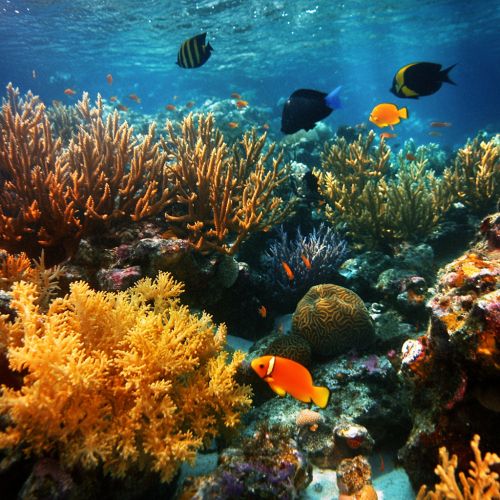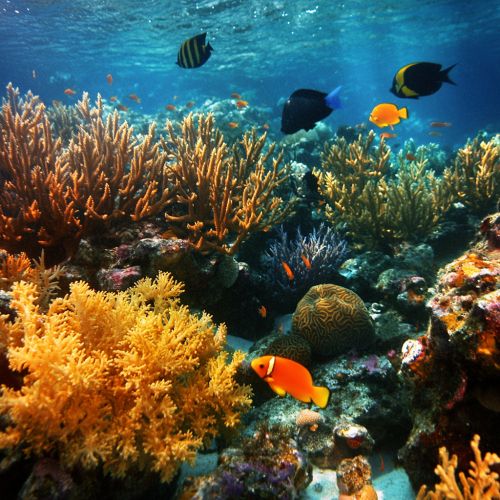Aquatic Life
Introduction
Aquatic life encompasses all organisms that live in water environments, including oceans, seas, rivers, lakes, and ponds. These organisms range from microscopic plankton to the largest animals on Earth, such as the blue whale. Aquatic ecosystems are incredibly diverse and complex, playing a crucial role in the global environment and human life.
Types of Aquatic Environments
Aquatic environments can be broadly categorized into two main types: marine and freshwater.
Marine Environments
Marine environments cover approximately 71% of the Earth's surface and include oceans, seas, and coral reefs. These environments are characterized by high salinity and host a vast array of life forms.
Oceans
Oceans are the largest marine environments, divided into five major basins: the Pacific, Atlantic, Indian, Southern, and Arctic Oceans. Each ocean has distinct physical and chemical properties that influence the types of organisms found there.
Seas
Seas are smaller than oceans and are partially enclosed by land. Examples include the Mediterranean Sea, the Caribbean Sea, and the South China Sea. Seas often have unique ecosystems due to their semi-enclosed nature.
Coral Reefs
Coral reefs are diverse underwater ecosystems held together by calcium carbonate structures produced by corals. These reefs are home to a myriad of species, including fish, invertebrates, and algae. Coral reefs are often referred to as the "rainforests of the sea" due to their high biodiversity.
Freshwater Environments
Freshwater environments have low salinity and include rivers, lakes, ponds, and wetlands. These environments support a different set of organisms compared to marine environments.
Rivers and Streams
Rivers and streams are flowing freshwater systems that move continuously in one direction. They play a critical role in transporting nutrients and organisms from one area to another.
Lakes and Ponds
Lakes and ponds are standing freshwater bodies. Lakes are generally larger and deeper than ponds. These environments can support a wide range of life forms, including fish, amphibians, and aquatic plants.
Wetlands
Wetlands are areas where water covers the soil or is present near the surface for part of the year. They include marshes, swamps, and bogs. Wetlands are highly productive ecosystems that provide habitat for many species and play a crucial role in water purification and flood control.
Aquatic Organisms
Aquatic organisms can be classified into various groups based on their size, habitat, and ecological role.
Plankton
Plankton are microscopic organisms that drift in the water column. They are divided into two main categories: phytoplankton (plant-like organisms) and zooplankton (animal-like organisms). Plankton form the base of the aquatic food web and are essential for the survival of many larger species.
Nekton
Nekton are actively swimming organisms that can move independently of water currents. This group includes fish, cephalopods, and marine mammals. Nekton play a significant role in the aquatic food web as both predators and prey.
Benthos
Benthos are organisms that live on or near the bottom of aquatic environments. They include a wide range of species, such as crustaceans, mollusks, and certain types of algae. Benthos are crucial for nutrient cycling and sediment stabilization.
Aquatic Plants
Aquatic plants, also known as hydrophytes, are plants that have adapted to living in water environments. They can be found in both freshwater and marine environments and include species such as water lilies, seagrasses, and algae. Aquatic plants play a vital role in providing oxygen and habitat for other organisms.
Adaptations to Aquatic Life
Aquatic organisms have evolved a variety of adaptations to survive and thrive in their environments.
Respiratory Adaptations
Many aquatic organisms have specialized structures for respiration. Fish, for example, use gills to extract oxygen from water, while marine mammals have lungs and must surface to breathe air.
Locomotion
Aquatic organisms have developed various methods of locomotion to move efficiently through water. Fish use fins and a streamlined body shape to swim, while cephalopods like squids use jet propulsion.
Buoyancy
Buoyancy is crucial for aquatic organisms to maintain their position in the water column. Many fish have a swim bladder, an internal gas-filled organ that helps them control their buoyancy. Other organisms, like plankton, have oil droplets or gas vacuoles to stay afloat.
Sensory Adaptations
Aquatic environments often have low visibility, so many organisms rely on other senses to navigate and find food. Fish have a lateral line system to detect vibrations in the water, and some marine mammals use echolocation.
Human Impact on Aquatic Life
Human activities have significantly impacted aquatic life and ecosystems.
Pollution
Pollution from industrial, agricultural, and urban sources has led to the contamination of water bodies with harmful substances such as heavy metals, pesticides, and plastics. This pollution can have detrimental effects on aquatic organisms and ecosystems.
Overfishing
Overfishing has led to the depletion of many fish populations, disrupting food webs and ecosystem balance. Sustainable fishing practices are essential to ensure the long-term health of marine environments.
Habitat Destruction
Habitat destruction, such as the draining of wetlands and the destruction of coral reefs, has led to the loss of critical habitats for many species. Conservation efforts are needed to protect and restore these habitats.
Climate Change
Climate change is causing shifts in temperature, sea levels, and ocean acidity, which can have profound effects on aquatic life. Species may be forced to migrate, adapt, or face extinction due to these changes.
Conservation Efforts
Efforts to conserve aquatic life and ecosystems are crucial for maintaining biodiversity and ecosystem services.
Marine Protected Areas
Marine protected areas (MPAs) are regions of the ocean where human activities are restricted to protect biodiversity and ecosystems. MPAs can help preserve critical habitats and allow fish populations to recover.
Sustainable Fishing
Sustainable fishing practices aim to balance the needs of human consumption with the health of fish populations and ecosystems. This includes setting catch limits, protecting breeding grounds, and reducing bycatch.
Pollution Control
Efforts to reduce pollution include improving waste management, reducing the use of harmful chemicals, and promoting clean energy sources. These measures can help protect water quality and aquatic life.
Habitat Restoration
Habitat restoration projects aim to restore degraded ecosystems, such as replanting mangroves, restoring wetlands, and rebuilding coral reefs. These efforts can help support biodiversity and ecosystem resilience.
See Also


